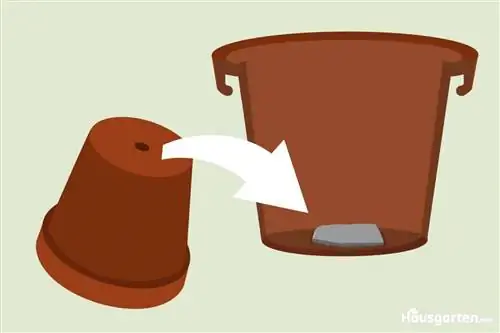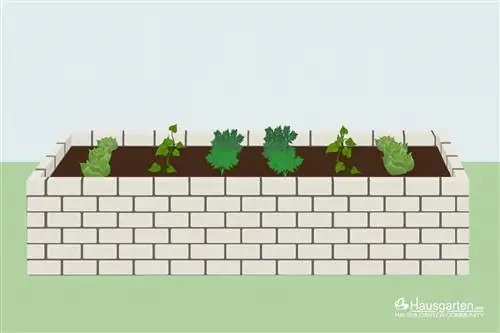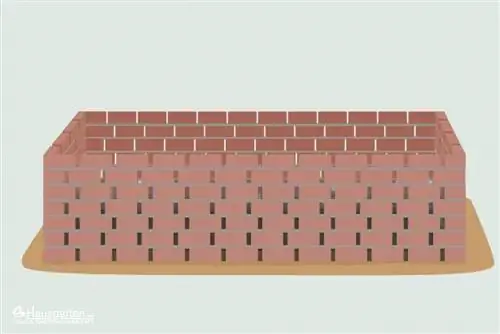- Author admin [email protected].
- Public 2023-12-17 03:39.
- Last modified 2025-01-24 12:45.
Originally borrowed from urban gardening, the lettuce cane enables numerous hobby gardeners and self-sufficient people with limited space to grow lettuce in a small space. We explain here in just a few easy-to-understand steps how you can build your own and which aspects of the lettuce tree really count.
What is a salad cane?
Ever since urban gardening became socially acceptable, a wide variety of options have been circulating to grow many plants in a small space, or even to use areas that are not greenable to grow vegetables. One of the essential core elements of this idea is the path to heights. Where there is no space at ground level, the cultivated area should grow upwards and thus create an adequate balance. While other variants, such as the vegetable hanging basket, simply divide the horizontal growing area into small pieces and stack them on top of each other, the lettuce tree actually manages to rotate vertically. Similar to the bark or trunk of the tree that gives it its name, the growing area runs vertically from bottom to top, with the individual lettuce plants growing laterally out of this area. The growth substrate is housed in the lettuce tube, while the water supply inside the tree follows gravity from top to bottom.
The salad tube practically implemented
Now that the basic principle of growing lettuce vertically in a vertical tube is known, it's time to put it into practice. Ultimately, you can build your own with little commercially available material:
Materials
- Plastic pipe, diameter approx. 20 centimeters, length up to a maximum of 2.00 meters, e.g. sewer pipe, or other dimensionally stable pipes
- Remaining pieces of cardboard, for example old packaging box
- Flowerpot. Diameter at least 40 to 50 centimeters, height at least 30 centimeters
- Coaster, matching the pot
- Garden soil
- Gravel, sand or stones
- Remaining piece of drainage fleece, alternatively insect screen or similar
Tools
- Hacksaw
- Forstner drill bit, diameter approx. 40 millimeters
- Gardener shovel
Preview
Once the materials have been procured and the tools are ready, you should think carefully about what your own salad tube should look like before starting the first steps. The following questions can be used to help. The effects of the individual answers on the construction are then explained in each step of the work:
- How is the planned location exposed? One-sided or from all sides?
- What height is available at the proposed parking space?
- How exposed to wind and weather will vertical cultivation be in the future?
- How much and which type of lettuce do I want to grow at the same time?
Once you have prepared the appropriate answers, let's start with the actual work.
The Pipe
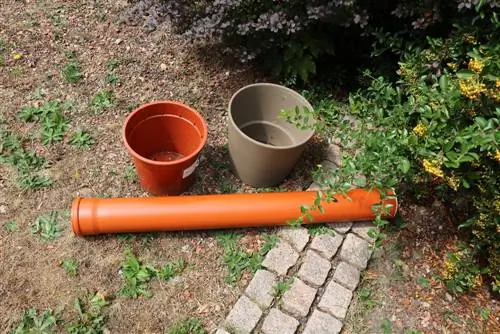
The core element of the lettuce tree is the plastic tube. It takes the earth as a basis for growth and at the same time ensures the structure's stable, upright position as a skeleton.
- Cut the pipe to the desired length, measure the maximum length so that there is space above to fill in the irrigation water
- Drill openings for lettuce plants with a Forstner bit, depending on the exposure on one side or on all sides around the pipe jacket
- Do not drill the bottom 40 centimeters to ensure stability
- Select hole spacing depending on the planned lettuce variety, analogous to the planting distance in the open field
- Measure the number of holes according to the pipe size and the desired number of salads
ATTENTION:
The maximum pipe height should not exceed 2.00 meters. The salad is poured from above into the pipe, with the water spreading downwards and unneeded residues emerging last at the bottom. If the pipe is too long, the water no longer reaches all plants reliably and leads to a strong dry-wet gradient from top to bottom.
The more lettuce plants you want to grow at the same time, the larger the pipe diameter should be. However, the entire object becomes very unwieldy when the diameter exceeds 30 centimeters, so you should consider a second tree as an alternative when growing large quantities.
The stand
The flower pot is used to ensure a secure stand. Weighted by its filling, it should be dimensioned in relation to the pipe in such a way that a secure stand is guaranteed. Exposed locations that are exposed to wind and weather require a larger pot than sheltered locations on a balcony or terrace.
- Fill the flower pot with two to three centimeters of sand
- Place drainage fleece or fly screen around the lower end of the pipe and secure it with a rubber band or binding wire
- Place the pipe in the middle of the sand bed
- Fill the flower pot evenly on all sides with sand, gravel or stones up to the top edge
- Press the filling firmly and check that the tube is securely held every now and then while filling
Filling
After the basic structure has been created and a secure footing has been ensured, it's time to fill the lettuce tree with life.
- Fill the garden soil from top to bottom into the pipe and press it lightly every 20 to 30 centimeters with a stick or broom handle
- When reaching the individual holes, adjust the top edge of the cardboard to prevent the soil from falling out of the holes during filling
- Leave the top 15 centimeters of the pipe free
Tip:
Planting
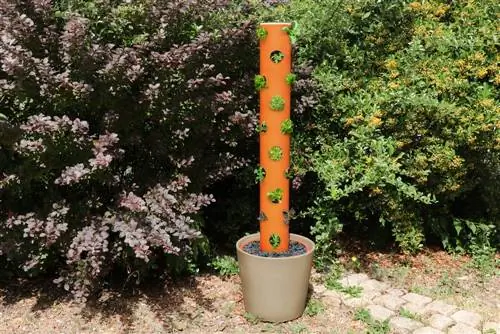
Once the soil is completely filled and pressed down, it holds on its own and the box is no longer necessary. Bit by bit, the simple sewer pipe can be transformed into a living green column, or even a lettuce tree, through the planting.
- Remove cardboard from hole
- Use your fingers to press a hole in the ground at an angle downwards
- Insert the lettuce plant and press the soil lightly on all sides
ATTENTION:
Despite being grown vertically, lettuce - like all plants - tends to grow upwards against gravity. The plants should therefore not be planted at right angles to the pipe, but rather with the leaves pointing slightly upwards. This means that the direction of growth is already determined and the plants can develop better.
The company
In just a few simple steps, we have now created numerous opportunities for growing your own lettuce in the best urban gardening tradition on a small footprint. And this is how the operation of the lettuce tree works:
- Plastic pipe in a weighted plant pot as a static skeleton for vertical cultivation
- Soil in the pipe as a support for the plants and a supply medium with nutrients and water
- Sand in the plant pot as drainage against standing water in the pipe
- Drainage fleece to retain the soil in the pipe and prevent it from being washed out into the drainage layer
- Empty pipe head as a filling area for the irrigation water
- Watering all plants via gravity-driven water flow from top to bottom
- Excess irrigation water escapes through the drainage in the pot into the saucer
- Coaster therefore indicates watering requirement: dry=watering, wet=no watering required
More even watering
The higher the pipe, the more unequal the water supply in the pipe. While the water quickly drains downwards from the top areas, it accumulates there before being drained into the pot. In order to achieve a more even distribution, you can insert a perforated, thinner plastic pipe with a diameter of around 20 to 30 millimeters into the inside of the actual pipe before filling it with soil and only add soil to the area between the two pipes. The inner tube, on the other hand, is filled with sand. When watering, the water is simply poured into the inner tube and sinks from top to bottom in the sand. Meanwhile, the perforation of the inner tube ensures that all lettuce plants are evenly supplied with moisture.
NOTE:
Such an elaborate construction is particularly worthwhile with long pipe lengths and many lettuce plants. Ideally, the outer pipe diameter should also be slightly larger in order to still provide enough soil.


